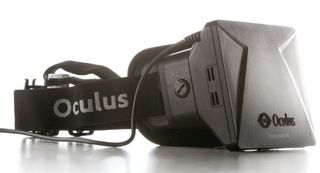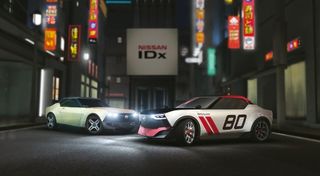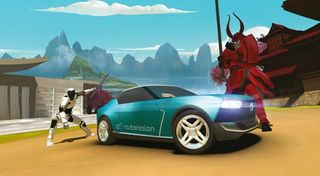Why Oculus Rift is the next big thing in interactive design
AKQA's executive creative development director Andy Hood considers why the Oculus Rift VR headset could revolutionise how agencies approach experience-based design.
Everyone knows what a VR headset is - we've seen them in movies since the '70s and witnessed the attempts at launching products in the '80s and '90s. So is there anything amazing in the Oculus Rift? Our familiarity with the concept tends to lead to people approaching their first Rift experience in a nonchalant manner. At the end of their journey through some Oculus Rift demos, however, the wide eyes and open mouths reveal that a completely new view of the future has just made itself known.
That's how good the experience of using Oculus Rift is. Even after testing the first developer prototype Oculus released as a result of the hugely successful Kickstarter campaign, it is hard to prepare yourself for the sheer physicality of the experience.
So, it's good. Find one and see for yourself. But so what? When augmented reality first appeared to consumers a few years back, it was a revelation. Suddenly we could see animated characters through our webcams, courtesy of a QR code we might have found on a box of cereal, and we were awed. The wonders would never cease, we thought. But the novelty wore off, and it's taken years for smartphone technology to enable useful real-world applications of augmented reality (AR) to become popular. So what of virtual reality (VR), and what of Oculus Rift ? How can this tech succeed where its predecessors have failed?

The answer is content. The concept of VR has been around for so long that many have been waiting for its arrival to implement their ideas. There is a huge array of developers creating all kinds of content for the Rift , which means that the device will be well served aft er it launches. Lack of content can be the death of any platform, but Oculus Rift will not be found wanting here.
The Trojan Horse, naturally, is gaming. A popular thought upon experiencing immersive VR for the first time is, "What would Call of Duty be like with this?" and clearly there will be many Rift-enabled games around. The Rift will become the Christmas gift of choice for a vast number of game-crazed people. And don't assume it will be expensive - mass adoption will surely be more important than anything else in the early stages.
With any number of Rift s finding their way into households through gaming, the path will be set for many other applications of immersive VR to follow. For example, education - why teach children about the Battle of Hastings when we can put them right in the middle of it? Perhaps they will be able to experience the processes of biology, chemistry and physics from the inside. And of course engineering and design - VR is the ultimate simulator. We can explore places we could never go from the comfort of the living room. Once you start coming up with applications it's hard to stop. Productised immersive VR is a game-changer for everyone. There are few walks of life where it will not have an impact.

This all comes with plenty of questions. When the technology goes mainstream, will there be any form of governance or will the world be deluged with the VR-equivalent of 'fart apps'? Will the morass of applications with more bugs than features that currently permeates app stores be replicated here? Will developers pay as much attention to navigation and control as they will to stunning environments and 3D models?
Get the Creative Bloq Newsletter
Daily design news, reviews, how-tos and more, as picked by the editors.
Navigation is a vital tool in maintaining the totally immersive nature of the VR experience - being tied to external controllers is a limiting factor here. It is also very difficult to predict how long the VR revolution will take. It's possible that once the immediate rush of gamers buying the Rift is over, we may see a plateau in the adoption of VR.
Things may go a little quiet while a broader and more utility-focused range of applications are worked out, tested and developed. Or it could be that many of them are ready from day one. What I think is abundantly clear is that whether it takes five weeks or five years, immersive VR is very much here to stay, and its impact will be felt far and wide.
For those of us who seek to apply new technologies to solve the problems of businesses and consumers, Oculus Rift is the kind of thing we live for, an exciting new medium with a whole realm of possibilities. The risk, however, is seeing the technology first and making our application of it entirely arbitrary.
It is pretty easy for most people to spot when technology has been crowbarred into a solution because it's 'cool'. The consumer experience is pivotal, and whether or not it is truly served by the technology, whether the solution genuinely fits the problem, is key.

We are almost certain to have to put up with a lot of pointless or substandard content. This is true of every medium, be it books, films, music or iPhone apps, so nothing to unduly worry about. We must concern ourselves with delivering the content, applications and solutions that can truly make this medium indispensable, and solve problems in a uniquely seamless and sophisticated way, as though only VR could ever really have been the natural solution to the problem.
That last point is true of all technologies. Oculus Rift is the current hot topic, but there will be others. We find them everywhere. Startups are creating new technologies and techniques all the time. You better believe that the tech giants are hard at work on their next offerings. Kickstarter is a brilliant place to keep track of anything at grassroots level. It enables you to place a pretty small bet on a technology or product, get the very first belt-and-braces prototype off the assembly line, and then realise major opportunities if you can find the relevance and deliver genuinely valuable solutions using it. And if you don't think that's worth getting out of bed for, then you're in the wrong industry.
Words: Andy Hood
This article originally appeared in Computer Arts issue 225.

Thank you for reading 5 articles this month* Join now for unlimited access
Enjoy your first month for just £1 / $1 / €1
*Read 5 free articles per month without a subscription

Join now for unlimited access
Try first month for just £1 / $1 / €1
The Creative Bloq team is made up of a group of design fans, and has changed and evolved since Creative Bloq began back in 2012. The current website team consists of eight full-time members of staff: Editor Georgia Coggan, Deputy Editor Rosie Hilder, Ecommerce Editor Beren Neale, Senior News Editor Daniel Piper, Editor, Digital Art and 3D Ian Dean, Tech Reviews Editor Erlingur Einarsson and Ecommerce Writer Beth Nicholls and Staff Writer Natalie Fear, as well as a roster of freelancers from around the world. The 3D World and ImagineFX magazine teams also pitch in, ensuring that content from 3D World and ImagineFX is represented on Creative Bloq.
